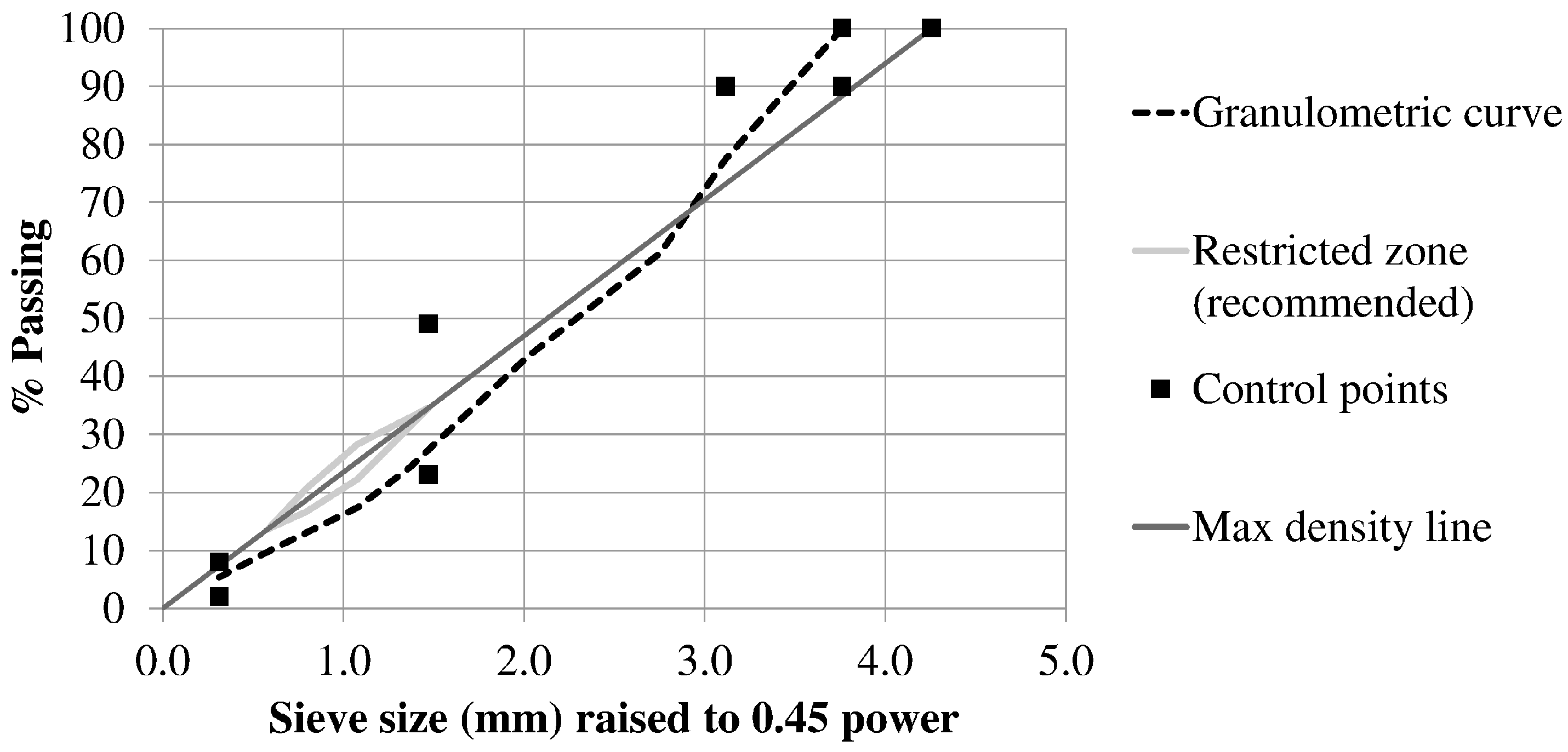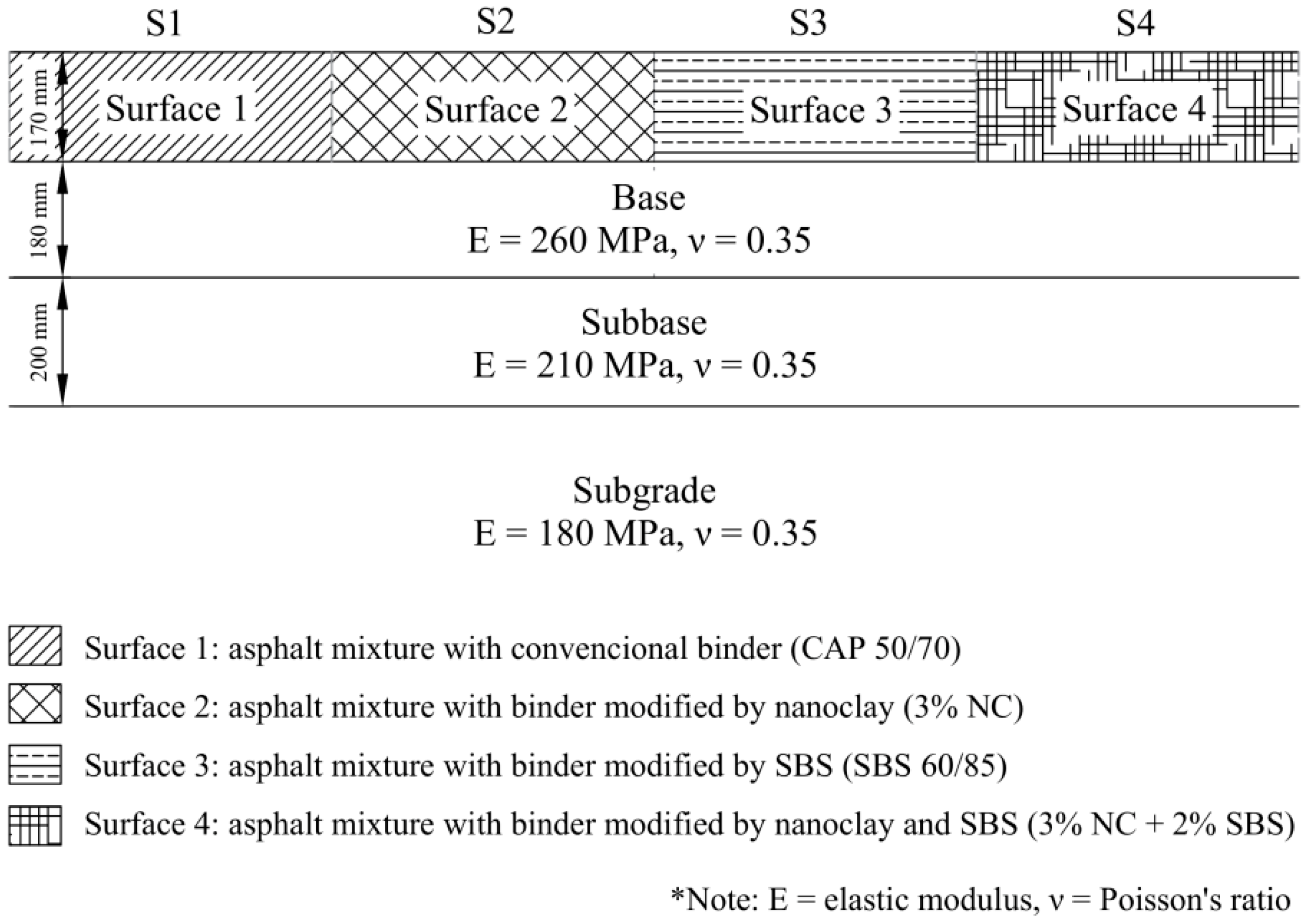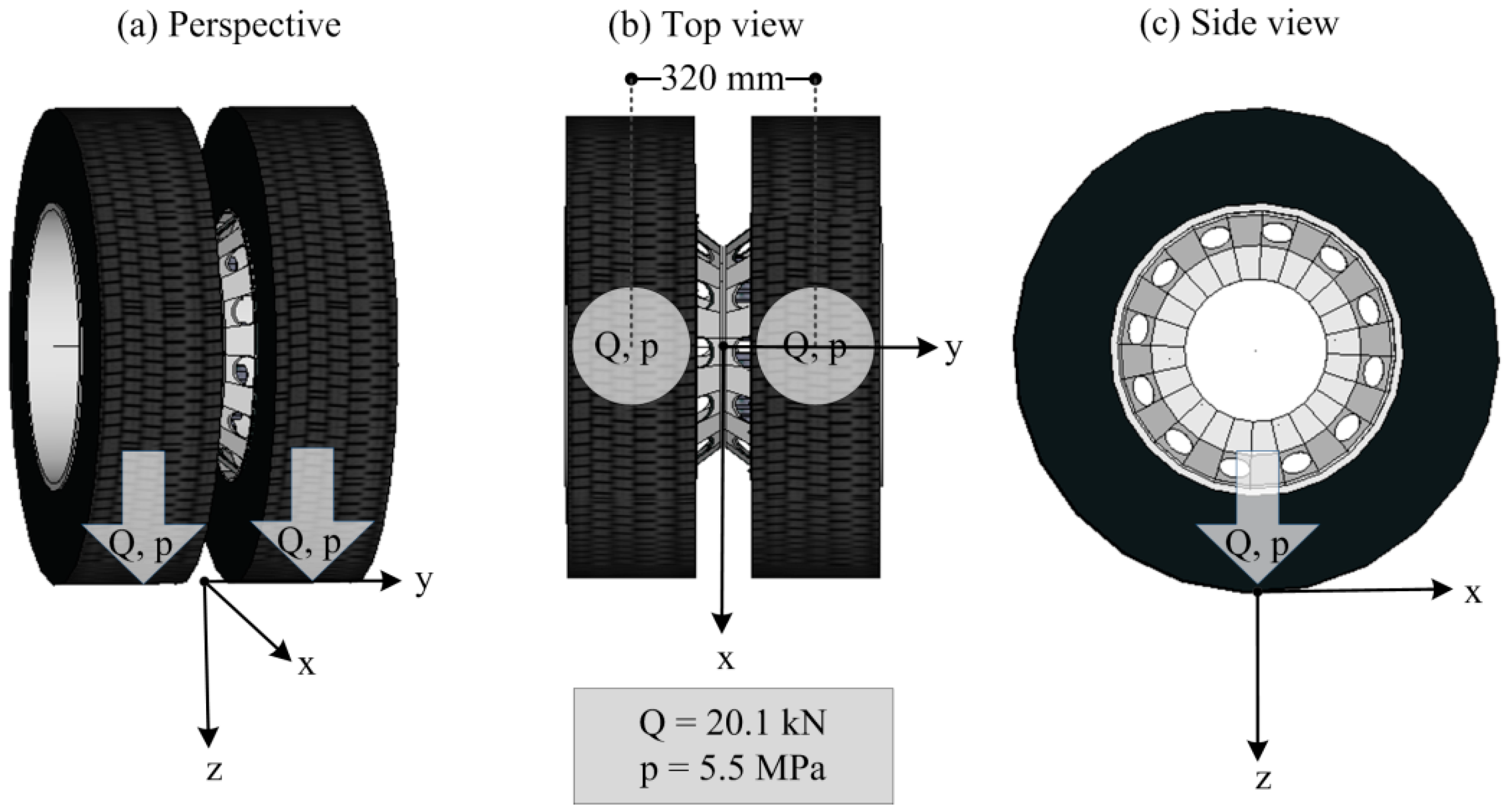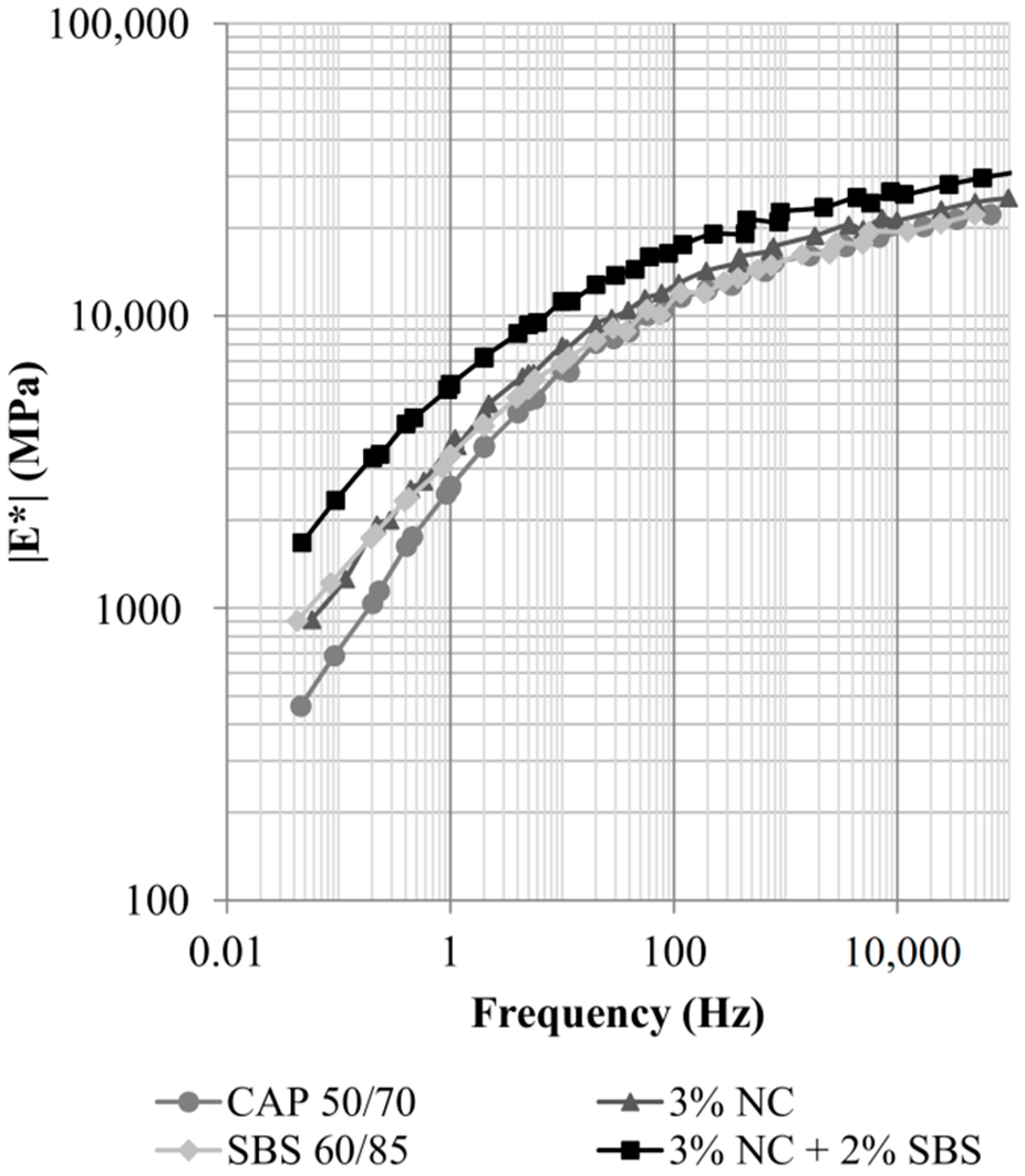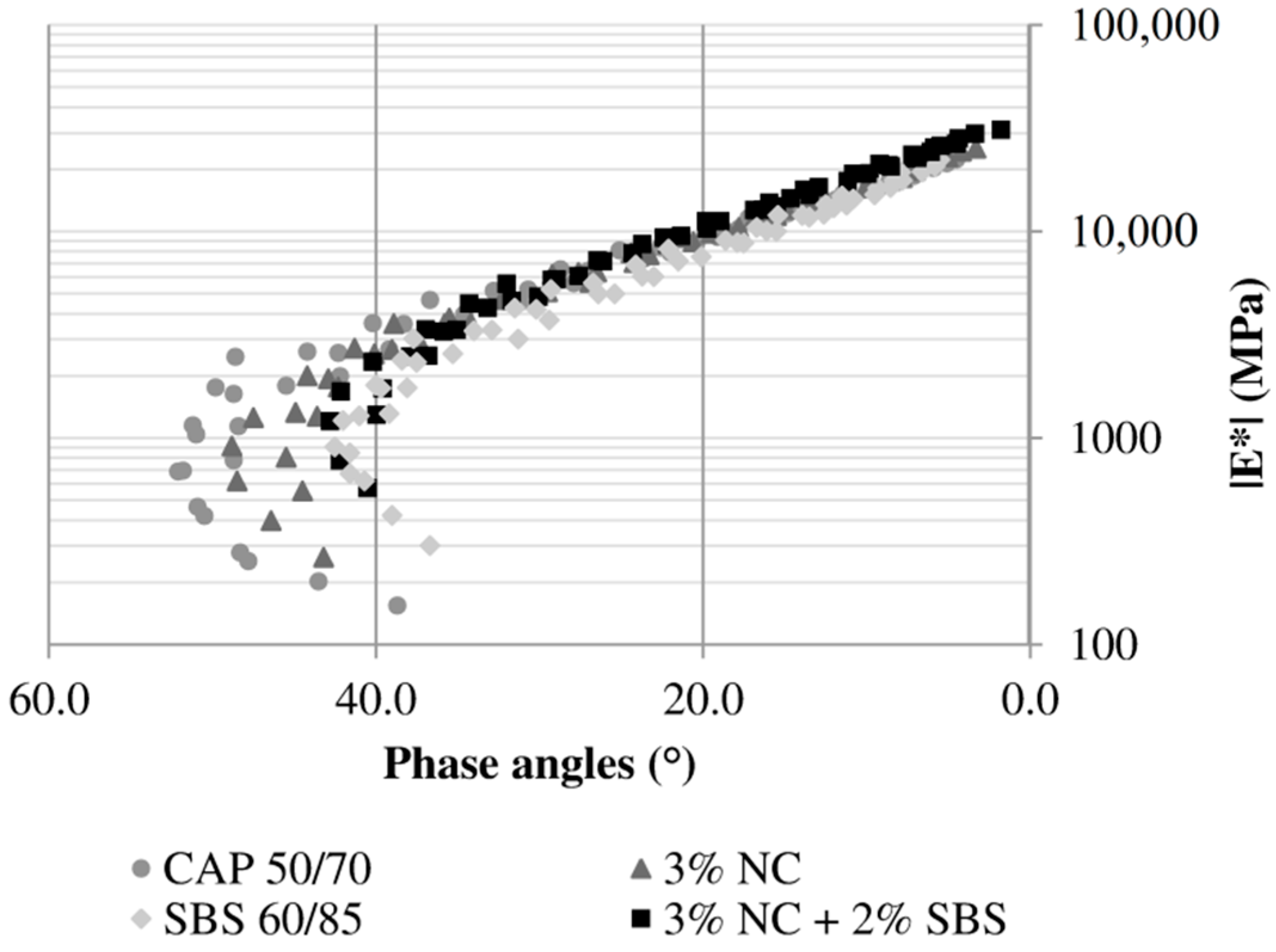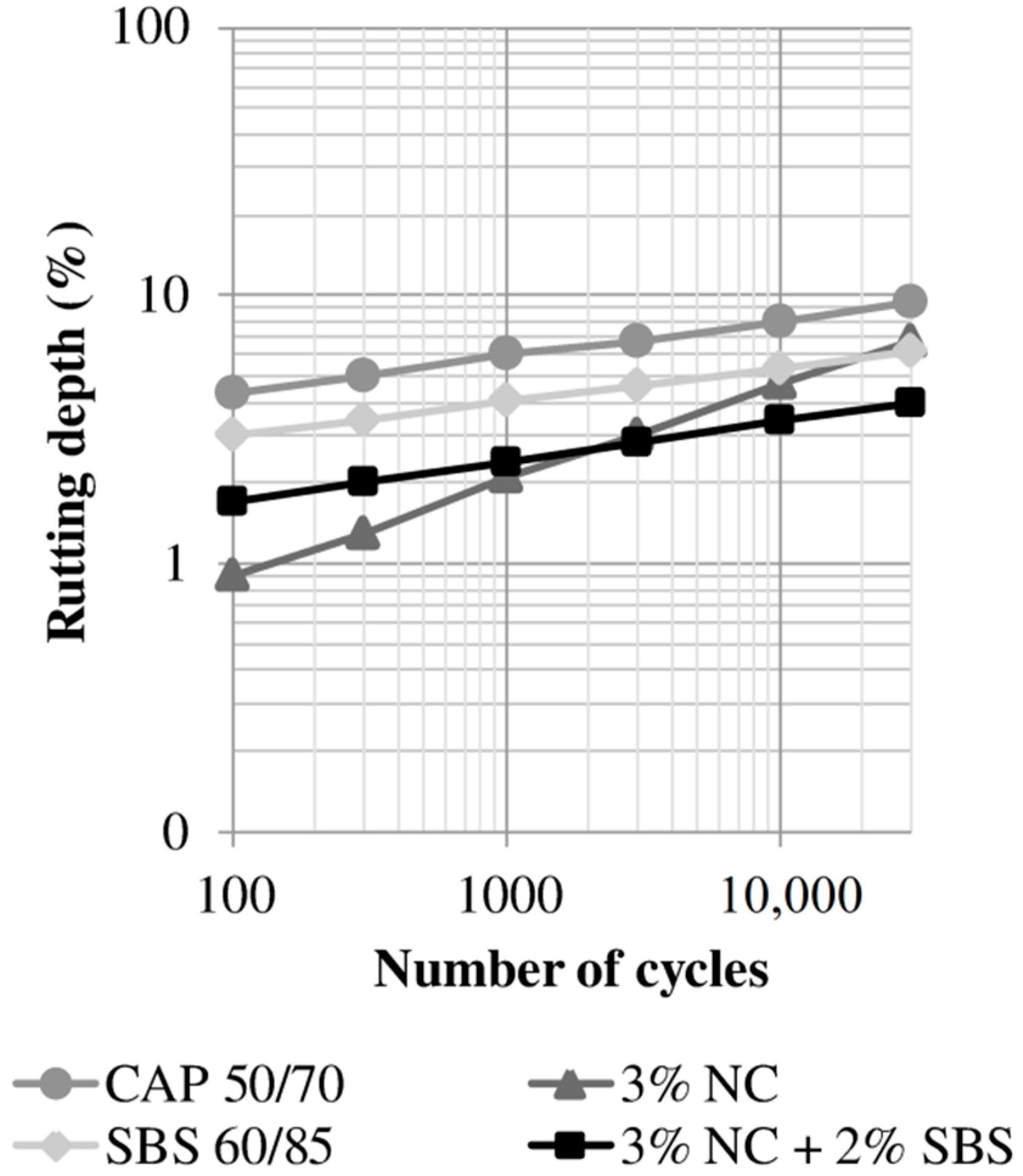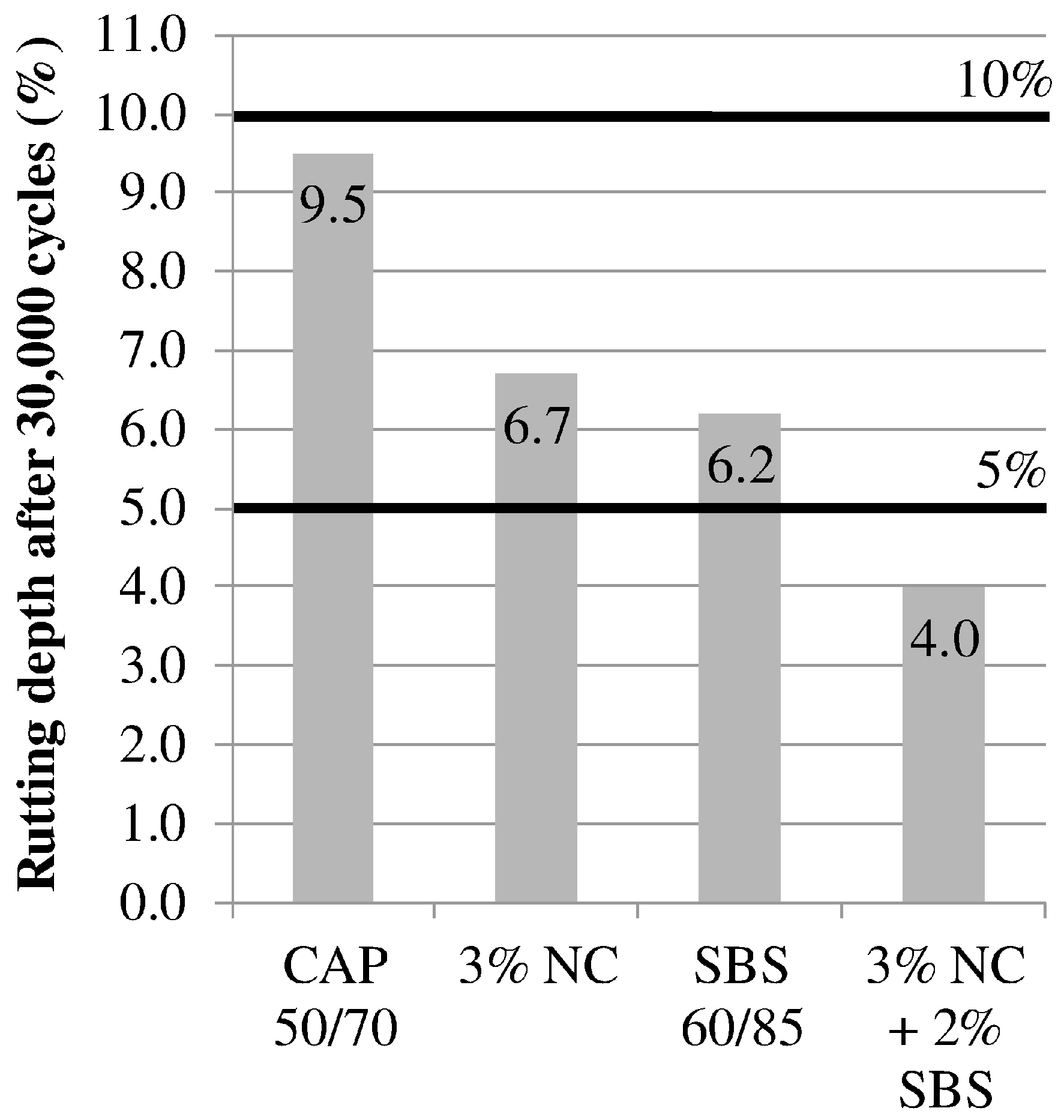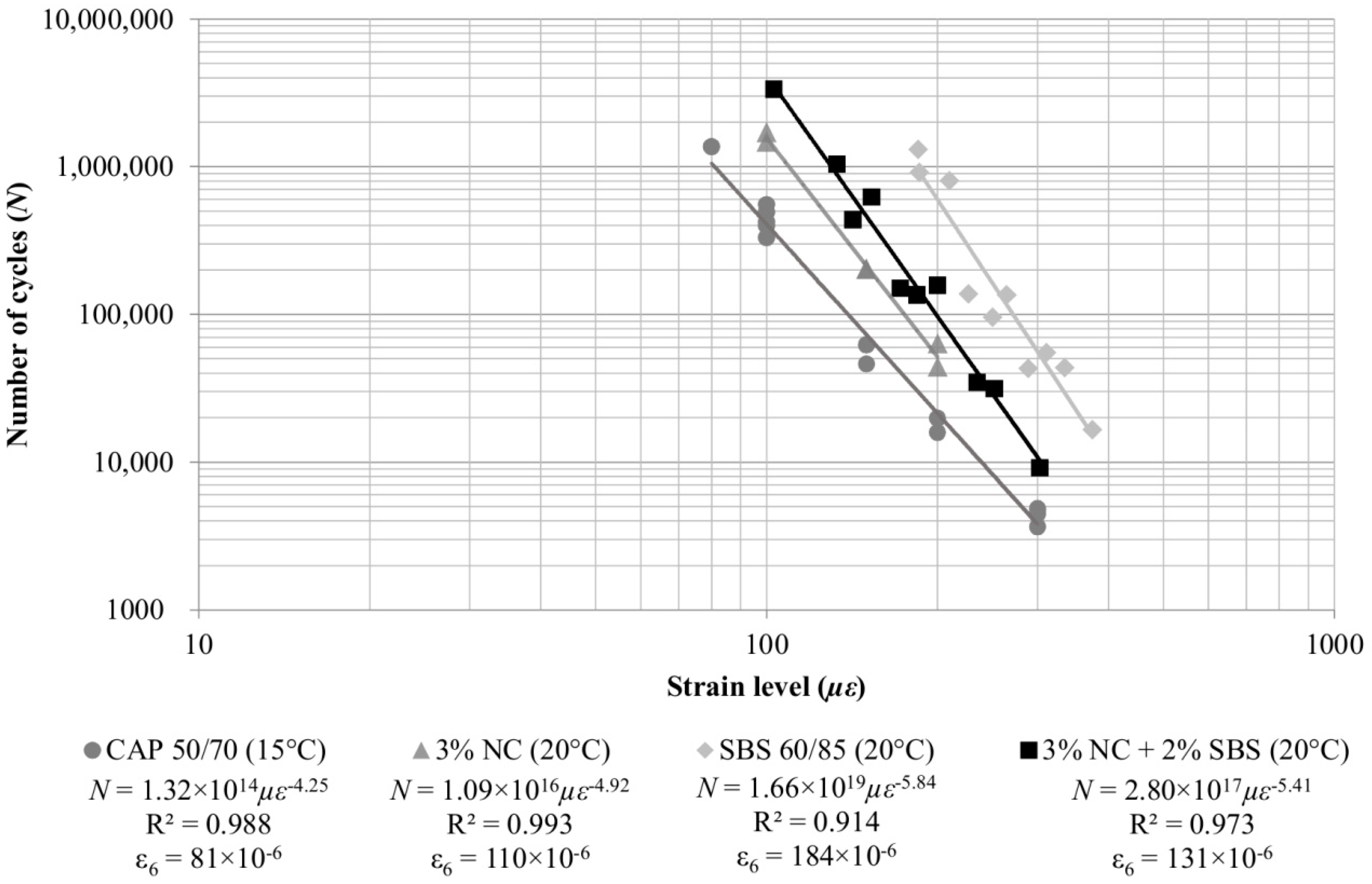2.2. Methods
This study was carried out in seven stages.
Firstly, in Stage 1, the modification of the conventional binder and the characterization of the modified binders were carried out. In this stage, the binders 3% NC (modified by 3% nanoclay in relation to the weight of CAP 50/70) and 3% NC + 2% SBS (modified by 3% of nanoclay and 2% of SBS polymer) were obtained. The content of nanoclay was established as 3% based on the results of a previous optimization study developed by Melo [
22], who evaluated the permanent deformation resistance of asphalt mixtures produced with binders modified by 1%, 2%, and 3% of nanoclay and verified a better performance for the 3% NC mixture. This nanoclay content was also identified in a recent study [
39] as the most frequent value mentioned in the related literature. The addition of 2% SBS together with 3% NC was aimed at obtaining an asphalt material with elastic recovery. Low polymer content was adopted based on results reported by Pamplona et al. [
20], who studied the modification with 2.5% of nanoclay and 2.5% of SBS, and also for economic reasons. It means the authors would like to produce a binder with reduced polymer content due to the cost of this material. However, another optimization of the modifier amount, including the SBS content, is recommended for future studies.
The inclusion of nanoclay and the polymer SBS in the base binder CAP 50/70 was carried out in a laboratory high shear mixer (Silverson, model L5M-A), and the modification procedures were defined based on studies reported in the literature [
5,
11,
12,
15,
16,
17,
18,
19,
20]. The modification to produce the 3% NC binder was carried out at 150 °C, with a shearing speed of 5000 rpm and compatibilization period of 100 min. In this regard, the previously mentioned literature review study [
39] also identified the following values as more frequent in similar studies: temperature of 160 °C, mixing speed of 4000 rpm, and mixing process duration of 120 min. This indicates this work is consistent with the literature, since the adopted and mentioned values are close. In the case of the 3% NA + 2% SBS binder, a modification temperature of 180 °C and a mixing period of 180 min were adopted, maintaining the shearing speed of 5000 rpm. These differences in time and temperature of modification were established in order to allow the complete dispersion of the modifiers. However, it should be noted that this can also do some influence on the binders and mixtures behavior. It is also interesting to mention that, as the binders were produced using a laboratory high shear mixer, for the reproduction of these materials in large quantities, with the same characteristics and aiming at the adequate dispersion of the modifiers, it would be necessary to use of an industrial high-shear mixer or another solution that provides the same results in terms of modifiers dispersion.
After production, the modified binders were then characterized according to the following properties: penetration (ASTM D 5 [
35]), softening point ASTM D 36 [
36]), elastic recovery (ABNT NBR 15086 [
38]), phase separation (ABTN NBR 15166 [
40]), and apparent viscosity (ASTM D 4402 [
37]).
Stage 2 consisted of establishing the design binder contents of the asphalt mixtures, beginning the part of this study that aims to evaluate the influence of the modifiers when interacting in the asphalt mixtures. For this, the Superpave mix design method was applied, according to the standards AASHTO M 323 [
41] and AASHTO R 35 [
42], with the use of a gyratory compactor. Considering a maximum nominal size of the aggregate of 19 mm and a heavy volume of traffic, the binder contents of the design correspond to the following dosage criteria that were met simultaneously: (1) percentage of void volume in Ninitial (9 spins, Vv@Ninitial) > 11.0%; (2) percentage of void volume in Ndesign (125 spins, Vv@Ndesign) = 4.0%; (3) voids in mineral aggregate (VMA) ≥ 13.0%; (4) voids filled with asphalt (VFA) between 65% and 75%; and (5) dust to effective binder ratio between 0.8 and 1.6. It is important to note that, during the design mix and the subsequent steps, the asphalt mixtures were produced and compacted at temperatures of which the binder viscosities corresponded respectively to 0.17 Pa.s and 0.28 Pa.s.
In Stage 3, after the design binder content definition, for each mixture, three plates were molded with one having dimensions of 60 × 40 × 9 cm (for sawing and obtaining prismatic specimens for the complex modulus and fatigue tests) and two plates having dimensions of 50 × 18 × 5 cm (for the permanent deformation tests). This molding was carried out at the LCPC compacting table, following the recommendations of the French standard AFNOR NF P 98–250–2 [
43] for a heavy traffic highway. Plates with dimensions 60 × 40 × 9 cm were then sawn, and five specimens with dimensions close to 6.3 × 5.0 × 40.0 cm were obtained from each plate.
In Stage 4, the rheological behavior characterization of the different mixtures was evaluated. This characterization was based on complex module tests, carried out in a four-point bending test machine, following the recommendations of the European standard EN 12697–26 [
44]. For each asphalt mixture, two specimens produced in the previous stage were tested. These tests were carried out under alternating bending with the application of sinusoidal loading keeping the deformation amplitude at 50 µε. Temperatures of 0 °C, 5 °C, 10 °C, 15 °C, 20 °C, 25 °C, and 30 °C with load frequencies of 0.1 Hz, 0.2 Hz, 0.5 Hz, 1 Hz, 2 Hz, 5 Hz, 10 Hz, and 20 Hz, were evaluated. For the interpretation of the results, master curves and black spaces were analyzed. The master curves were built in the reference temperature of 20 °C, based on the TTS principle (time–temperature superposition) and by applying the Williams–Landel–Ferry equation, of which the constants were calculated using the Viscoanalyse software (developed by the LCPC).
In Stage 5, the resistance to permanent deformation of the four different mixtures was evaluated. In this stage, tests were performed in the French traffic simulator following the standard EN 12697–22+A1 [
45]. These tests were carried out at 60 °C, with the application of a single axle with single wheel load, intensity of 5 kN, tire inflation pressure of 0.6 MPa, and frequency of 1 Hz. The development of rutting recesses was measured after the following numbers of cycles: 100, 300, 1000, 3000, 10,000, and 30,000. The results of these tests after 30,000 cycles were compared to the limits established by the French [
46] and European [
47] guidelines.
Stage 6 consisted in evaluating the fatigue resistance of the asphalt mixtures. As mentioned for the rheological characterization, fatigue tests were also carried out in four-point bending test machine but followed the recommendations of the European standard EN 12697–24 [
48]. In this stage of the study, about fifteen specimens were tested for each mixture under controlled deformation at deformation levels between 80 and 375 µε (µm/m). These tests were performed considering a frequency of 10 Hz (simulating the vehicles speed, in practice, of 72 km/h [
49]) and at the temperatures between 15 °C and 20 °C (defined according to the average temperature of the region of this study). As a rupture criterion, it adopted a reduction of 50% of the initial complex modulus. At the end of the tests, it was possible to obtain the fatigue models of the mixtures, as presented in Equation (1):
where
N = number of cycles (loading applications) until asphalt concrete reaches 50% of initial stiffness;
με = maximum tensile strain applied on the material; and
k,
n = constants mainly dependent on stiffness and asphalt content of the mixture.
After that, in Stage 7, numerical simulations were carried out, considering the structures presented in
Figure 2 (S1, S2, S3, and S4 with the same subgrades, subbases, and bases but different asphalt layers). These structures were chosen for analysis and comparisons because they represent variations of the structure S1, which was constructed in a roadway in the region where the authors developed this work and where the asphalt surface presents early distresses. This road stretch with the structure S1 is being monitored by the authors in other projects. The simulations aimed at estimating the tensile strain suffered by the lower fibers of the asphalt layers during the passage of vehicles (at 170 mm depth, according
Figure 2). Thus, in the simulations, it was considered the load configuration shown in
Figure 3, at the speed of 20 m/s and the fatigue tests’ temperature. Applying this stage results to the fatigue models obtained in Stage 6, it was possible to estimate the lifespan in terms of asphalt concrete fatigue fracture of each structure analyzed. This procedure represents an initial estimation for comparisons, and lab to site shift factors can be applied in future researches. It also should be noted that the viscoelastic behavior of the asphalt mixtures was considered in the simulations by using the Huet-Sayegh rheological parameters, obtained from the results of Step 5.
